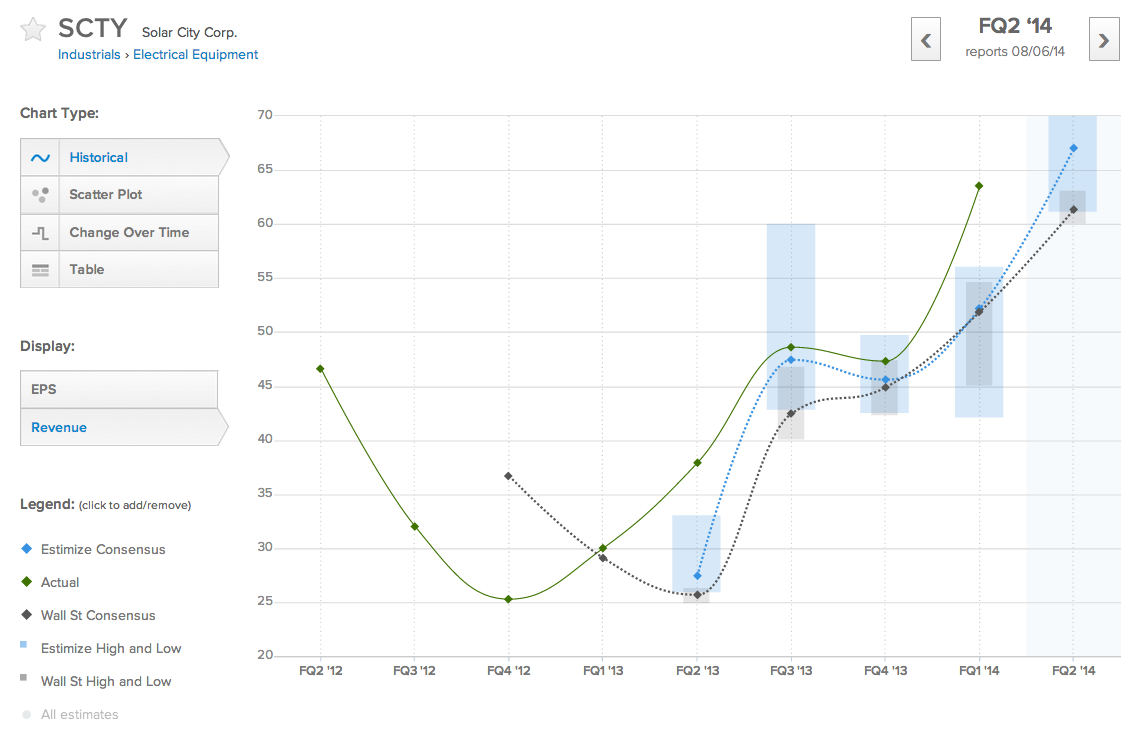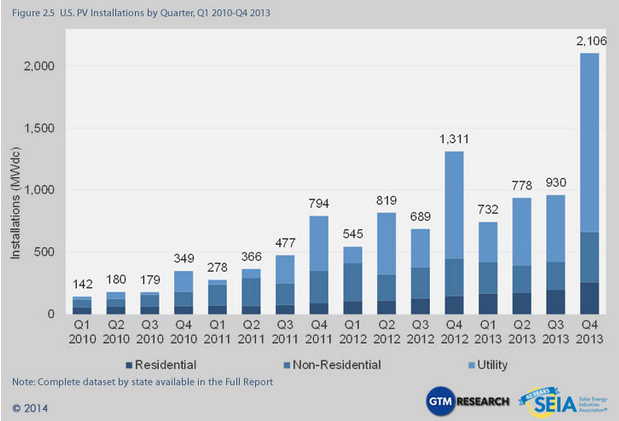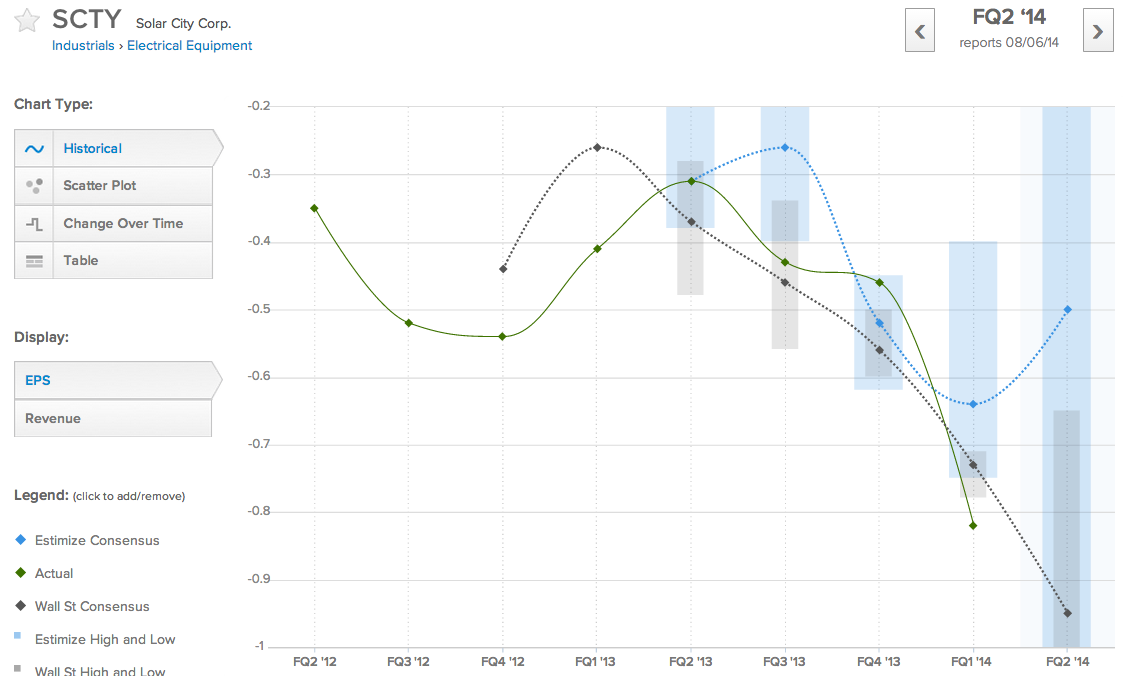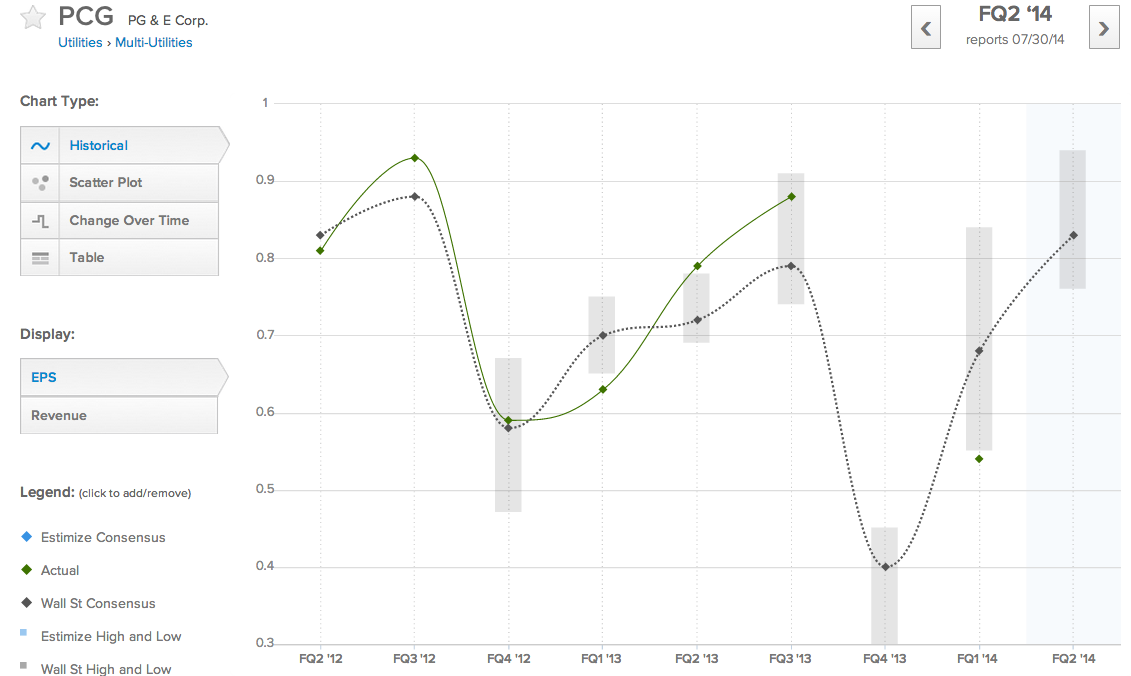Solar energy production in the United States is doubling every 2 years. The cost of installation has come down and the spread of a decentralized solar energy network is becoming more threatening to the energy industry each quarter. Just this week at the World Energy Innovation Forum at the Tesla (NASDAQ:TSLA) factory GE (NYSE:GE) CEO Jeff Immelt confessed he, “…missed SolarCity” and said, “My God I wish I had thought of that”. SolarCity (NASDAQ:SCTY) controls as much of the solar energy industry in the United States as the next 14 competitors combined. In today’s research note we dive into the business model SolarCity is using to dominate new solar installations and attempt to shed light on the growth and implications of a rising decentralized energy network.
With solar energy representing about 1% of national energy production, just how far are we from widespread penetration of at home solar energy generation? Solar energy production is now doubling every 2 years, which means we are much closer to mass adoption than most realize. People naturally struggle to wrap their head around exponential growth rates. That’s why we make all newbies to the financial industry write “I will not underestimate compound interest.” 100 times on the chalkboard.
If the proliferation of solar energy maintains the current growth rate of doubling every 2 years, we will go from 1% of total energy production to meeting 100% of our energy needs within only 7 doublings, or about 14 years. In an interview back in October on Youtube with DingXtra, Google (NASDAQ:GOOG) director of engineering Ray Kurzweil pointed out that we have 10,000 times as much sunlight as we need to meet global energy demands. That means the only barriers preventing us from actually harnessing solar energy are the time and cost associated with building the infrastructure. That’s where SolarCity comes into play.
The chart above from the Solar Energy Industries Association shows the rapidly increasing quarterly number of solar panel installations in the United States. The reason GE has thus far missed out on the solar energy trend, and one of the chief reasons why adoption has taken so long, is that companies have been focusing on the wrong part of the solar industry. Solar energy units remain prohibitively expensive for many if not most Americans, so selling solar panels directly to consumers has been a largely unsuccessful business.
According to Motley Fool contributor Wade Michaels, buying solar energy hardware can cost $10,000 for a single home which could be completely recovered through energy cost savings within 6 years, saving up to $36,000 over a 20 year period. What may come as a surprise about SolarCity is that despite having Elon Musk as chairman of the board, a new or proprietary technology is not what makes SolarCity unique or successful as a company. The power behind SolarCity’s expansion is a differentiated business model and financing options that make solar energy affordable to the middle class.
Through its SolarLease and SolarPPA payment plans, SolarCity offers flexibility to customers to either purchase the hardware upfront, put no money down and pay as they go, or find a happy middle ground. The pay as you go option is particularly attractive because customers can put no money down and see a reduction in their monthly energy bill immediately. An option to be cash flow positive from day 1 is a no brainer for those who have the option available.
One tailwind that’s been boosting SolarCity is that the price of solar cell wafers has come down dramatically. Toward the end of last year Charles Annis, vice president at NPD Solarbuzz said “Wafer costs are only a third of what they were five years ago, and even though the rapid pace of cost reduction is starting to decline, the severe oversupply and extremely low selling prices are forcing polysilicon and wafer makers to continue to find ways to lower costs to previously assumed impossible levels,” Long story short, solar energy panels have gotten much cheaper and are becoming a viable, if not dominant option to meet homeowners’ energy needs. They become exceptionally attractive when you factor in government subsidies and clean energy tax initiatives. GE and other more established energy-tech firms didn’t realize that the money to be made in solar was through installation and financing, not through the manufacturing of hardware. This brings us to our final point, SolarCity operates as an energy bank and financier, not a solar panel production company.
In many cases homes with SolarCity energy units produce more energy than they consume. In these situations the homeowner receives a credit for the surplus energy that SolarCity sells back to the power grid. According to SolarCity utility rates have risen historically about 5% per year. As more and more homes are equipped with solar units, the decentralized network will become stronger and produce an increasing supply of energy which is will be shared across the grid, driving down the average cost of energy. Solar power could be the end of 5% annual energy cost hikes and may spell big trouble for electric companies. Within the next decade or two it’s possible to imagine a scenario where the utility companies become regulators and maintainers of the energy grid infrastructure while energy is produced at a fraction of historical costs by individual homes instead of power plants.
Many analysts have focused on SolarCity’s lack of earnings. After learning more about SolarCity’s business model it shouldn’t come as too much of a surprise that the company is losing money right now. They are installing somewhat expensive solar panels at little or no cost to homeowners in exchange for 20 year payment contracts. With solar energy production doubling every 2 years and with SolarCity dominating the market for new installations, if current trend levels hold SolarCity will become a force of nature leading an energy revolution. Coincidentally on May 1st the largest electric company in California where SolarCity is based, PG & E Corp (NYSE:PCG), missed the Wall Street consensus by 14c per share and saw a year over year drop in FQ1 earnings of 14%.
With quarterly revenue still under $65 million, SolarCity still undoubtedly has a long way to go, but the company could take off quickly in coming years. How do you think SolarCity’s business model will play out in the company’s upcoming earnings reports? Head over to the Estimize.com platform and submit your own predictions for SolarCity and the electric companies.




